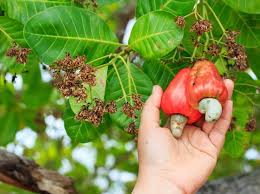The cashew plant, Anacardium occidentale, is native to Central and South America, with its main center of variation in eastern Brazil. Cashew is now grown in many parts of the world where growth is not limited by cold.
The annual world production of cashew nuts, that is the main commercial product of the cashew plant, is about 500,000 tons, with more than 60% of this production coming from South Asia and East Africa, particularly India and Tanzania.
Small quantities of cashew nuts are also produced in West Africa and Nigeria, where production is limited to peasant farmers in the North Central Zone of the country.
As a crop that is highly tolerant of poor soils, low soil moisture content, and low rainfall, cashew has proven to be a valuable cash crop in areas where other tree crops produce little or nothing.
Taxonomy
Cashew (Anacardium occidentale) is a member of the Anacardiaceae family, the same family to which mango belongs. It belongs to the genus Anacardium, which includes about 8 species of trees and shrubs, with Anacardium occidentale being widely cultivated throughout the tropics for its nuts.
The cashew tree is a medium-sized tree with a spreading canopy, often featuring drooping branches. Its mature height ranges from 10 to 11 meters.
Uses of Cashew
The seeds of the cashew tree are the source of cashew nuts, which are obtained by shelling the nested fruits. These nuts are used in confectionery and desserts. They also yield edible oil, but due to the high price of the kernels, this oil is not typically extracted.
The shells, or pericarp, yield cashew shell oil, which can be used as a waterproofing agent and as a preservative. If you distill and polymerize cashew oil, it can be used in insulating varnishes, as well as in the manufacture of typewriter rolls, oil, acid-proof cement and tiles, brake linings, inks, and more.
The cashew apple, which is the fleshy, swollen pedicel, is juicy, astringent, and edible. The juice can be fermented to make wine, and the pulp can be made into preserves. The sap from the bark can be used to make indelible ink. Additionally, the pulp of the apple can be fed to livestock.
Read Also: The Most Lucrative between Production of Fish Fingerlings or Raising them to Table Size
Origin and Distribution of Cashew
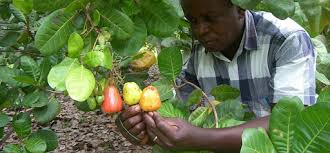
The cashew is native to tropical America, ranging from Mexico to Peru and Brazil, as well as the West Indies. It was one of the first fruit trees from the New World to be widely distributed throughout the tropics by the early Portuguese and Spanish adventurers.
The cashew was introduced into India from Brazil by the Portuguese in the 16th century, and it likely reached the East African coast and Malaysia around the same time. Cashew has since become naturalized in many tropical countries, including Nigeria.
Ecology of Cashew
The cashew is hardy and drought-resistant but is susceptible to damage from frost. It thrives under a variety of climatic and soil conditions and can be grown from sea level up to 300 meters, though it is best suited to lower elevations. Cashews require areas with rainfall ranging from 50 to 375 cm per annum.
The cashew grows best on sandy soils with good drainage, but it is often cultivated on hillsides that are too dry and stony for other crops.
Selection of a Site for Cashew Plantation
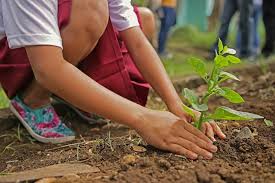
Unlike the other tree crops we have considered in this course, cashew can be grown under a wide range of ecological conditions. It is reasonably tolerant of low soil moisture content, and its growth is not adversely affected by high soil moisture.
However, it will not tolerate waterlogged conditions. The soil should be deep, well-drained, and the land should be reasonably flat for optimal growth.
Germination of Cashew Seeds
Cashew seeds have a very thick coat, which causes them to take a considerable amount of time to germinate. However, early germination can be achieved by the following methods:
1. You can crack the seed coat carefully, as this is a delicate operation that must be done with precision to avoid damaging the embryo and cotyledons.
2. Seeds can be treated with dilute sulfuric acid (H2SO4) to encourage germination.
3. Soaking the seeds in water for 24 to 36 hours before sowing them in seed boxes can also achieve quicker germination.
With any of these treatments, the seeds can germinate within two to three weeks. Once germinated, you can plant the seeds in filled polythene bags at the rate of one germinated seed per bag.
Chemical Composition of Cashew
The cashew nuts contain the following:
1. Water: 5%
2. Protein: 20%
3. Fats: 45%
4. Carbohydrates: 26%
5. Fibre: 1.5%
6. Minerals: 25%
The shell, or pericarp, contains approximately 50% cashew-shell oil, a viscous substance composed of 90% anacardic acid and 10% cardol.
The cashew apple, which is eaten fresh, contains:
1. Water: 88%
2. Protein: 0.2%
3. Fat: 0.1%
4. Carbohydrates: 11.6%
It is also very rich in vitamin C.
Read Also: Factors that Hinders your Fishes from Growing Fast
Propagation and the Nursery
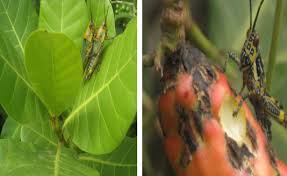
Cashew is typically propagated by seed, although research on vegetative propagation is ongoing. In the nursery, you should arrange polythene, mulch slightly, and water regularly. Shade is not usually required, except in very dry areas where light shade may be provided.
To control disease and pests, routine spraying of insecticides and fungicides should be carried out during the nursery period.
If polythene bags are unavailable, you can plant germinated seeds in nursery beds with spacing ranging from 30 x 30 cm to 45 x 45 cm. Mulch the nursery beds and water when necessary. Disease and pest control measures should also be implemented, and light shade may be provided if needed.
The nursery period for cashew lasts between four to six months, after which the seedlings should be transplanted into the field when rainfall is steady. You can also sow directly at stake.
Field Planting and Establishment
Shade is not required for cashew plants in the field. After land preparation, clear and fill the land, then divide the plantation into blocks of 4 ha units or according to the size of the land.
The recommended planting spacing is 9 x 9 m, 10 x 10 m, or 12 x 12 m, depending on the variety and the recommendation from the seed supplier. In the early years of a cashew plantation, dense populations are commonly utilized. During this period, the plantation may be intercropped with leguminous or vegetable crops.
Planting holes should be 60 x 60 x 60 cm.The main post-planting maintenance task is weed control. Ring weeding is sufficient for the crop in the early years. The establishment of a leguminous ground cover will also help control weeds.
Another key task is replacing missing or dead plants and providing watering or irrigation as needed, especially shortly after establishment. Pruning of the lowest side branches should occur at the end of the first year’s growth. This may also be necessary in the second and third years.
The objective of pruning is to ensure the main stem remains free of branches up to about 1 meter above ground level, as branches below this height could interfere with plantation operations.
Harvesting and Processing of Cashew
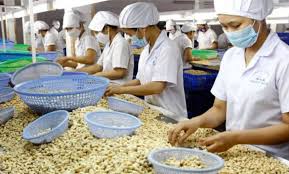
Economic bearing of cashew plants under good management typically begins in the fourth year of field planting. The first crop is usually small, but it gradually increases until the tenth year when the plants reach mature production. Flowering in cashew plants is usually very profuse, but only about 10% of the flowers set fruit.
Weeds in the orchard should be slashed very low to facilitate fruit development as the fruits approach maturity. Cashew fruits are not usually harvested by hand plucking. Instead, the fruits are allowed to drop from the trees and are then gathered.
Once the fruits are collected, the apple should be clearly removed from the seed. The nuts are then gathered and sun-dried until fully dried. The apple can be used to minimize waste in the following ways:
1. It can be sucked, with a slightly sharp but pleasant taste.
2. The juice can be extracted and processed into a soft drink or a potable alcoholic drink through fermentation, distillation, and clarification.
Cashew processing is a specialized operation, which can be done by farmers themselves or in an industrial plant. Both methods follow the same principles: roasting, followed by cracking and picking.
Cashew Processing
There are two methods of processing cashew nuts, depending on the quantity to be processed. For small quantities intended for individual family use, the nuts are dried and then inserted in hot wood ash for up to 30 minutes. Afterward, they are cracked on a stone, and the nuts are gathered for use, while the shell is returned to the fire as additional fuel.
For larger quantities processed by peasant farmers for sale in the market, a native pot is used for roasting the nuts. The nuts are placed in a clay pot and set on a wood fire.
As the temperature rises and the nuts begin to roast, the CNS oil in the shell exudes and accumulates. This oil aids in the roasting process. Once the nuts are fully roasted, they are removed for cracking and picking.
The industrial method is based on the same principles as the peasant farmers’ methods but uses machines for larger-scale processing. Various cashew nut processing machines are available in the market. Key components of a cashew processing machine include a nut cleaning chamber, grading chamber, cashew seed grading system, and a bagging unit.
Commercial cashew processing is specialized, and as labor costs continue to rise, processing plants are being modified to meet the evolving needs of the cashew industry.
Major Diseases and Pest in Cashew
Cashew plants are relatively free from disease. Mature trees are very hardy, but young seedlings are generally susceptible to the following diseases:
1. Seedling wilt: caused by Fusarium spp., which is encouraged by over-watering. It can be controlled by reducing watering and spraying with fungicides.
2. Leaf scab: occurs both in the nursery and in the field. Various fungal species have been identified as potential causes. Control can be achieved by spraying with copper-based fungicides.
3. Immature fruit drop: which is more of a physiological than a pathological problem, can be addressed by applying a balanced fertilizer rich in potassium.
4. Fruit rot: caused by excess moisture. Cashew cultivation should be avoided in high rainfall areas to reduce the risk.
Cashew plants are also vulnerable to a number of pests. The major pests and their control methods are:
1. White flies: Spray with Roger or Gamalin 20.
2. Longhorn beetle: Kill both the adult and larvae.
3. Fruit-piercing moth: Kill both the adult and larvae.
4. Thrips: Spray with Roger.
5. Flower beetles: Spray with Roger.
6. Leaf rollers: Spray with Roger.
7. Variegated locust: Spray with Gamalin 20.
Anacardium occidentale is a member of the Anacardiaceae family. It is widely cultivated throughout the tropics for its nut and apple, with the apple’s flesh typically consumed. The nuts yield an edible oil, while the shells or pericarps produce cashew-shell oil (CNS oil).
The cashew apple is also a valuable raw material for the soft drinks industry. Cashew can be regarded as a new crop with significant potential.
Cashew can be successfully cultivated in Nigeria and holds great potential as a commercial tree crop of economic importance.
Do you have any questions, suggestions, or contributions? If so, please feel free to use the comment box below to share your thoughts. We also encourage you to kindly share this information with others who might benefit from it. Since we can’t reach everyone at once, we truly appreciate your help in spreading the word. Thank you so much for your support and for sharing!
Read Also: Dangers of Mole Rats to Your Farm

